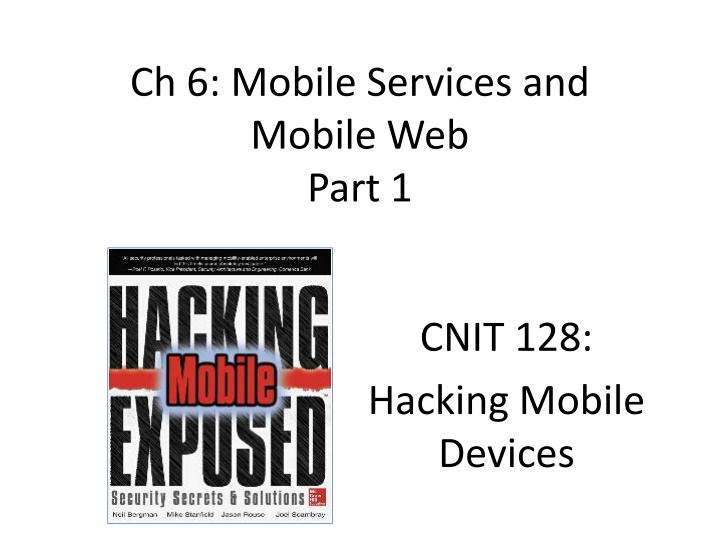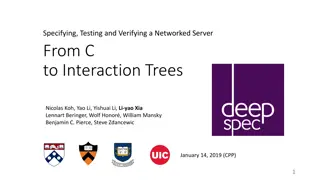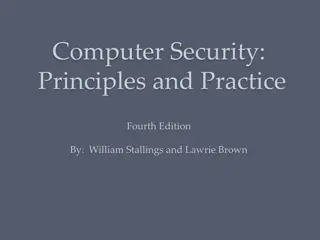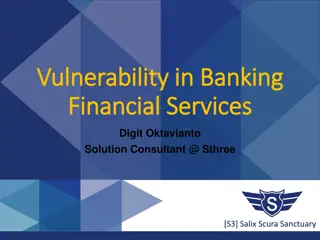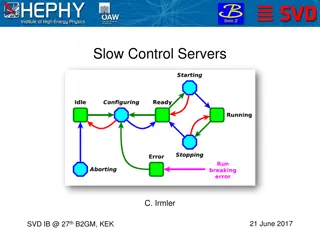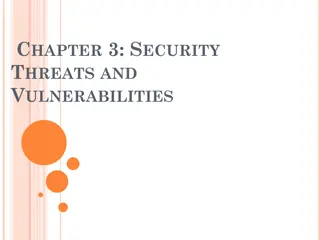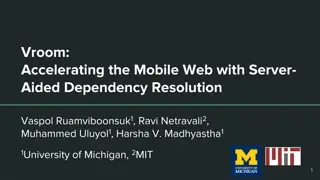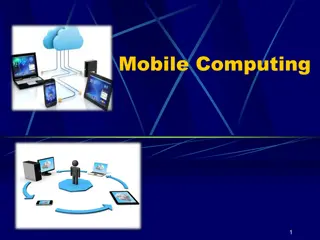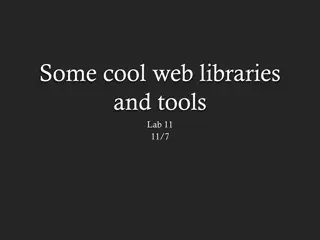Server-Side Technologies and Security Vulnerabilities in Mobile Services
This content delves into server-side technologies such as SQL, SOAP, JSON, and ReST used in mobile services, highlighting vulnerabilities that expose sensitive data. It emphasizes the importance of general web service security guidelines and discusses attacks against XML-based web services, outlining security audit measures to identify and address vulnerabilities.
Download Presentation

Please find below an Image/Link to download the presentation.
The content on the website is provided AS IS for your information and personal use only. It may not be sold, licensed, or shared on other websites without obtaining consent from the author.If you encounter any issues during the download, it is possible that the publisher has removed the file from their server.
You are allowed to download the files provided on this website for personal or commercial use, subject to the condition that they are used lawfully. All files are the property of their respective owners.
The content on the website is provided AS IS for your information and personal use only. It may not be sold, licensed, or shared on other websites without obtaining consent from the author.
E N D
Presentation Transcript
Ch 6: Mobile Services and Mobile Web Part 1 CNIT 128: Hacking Mobile Devices
Server-Side Technologies SQL (Structured Query Language) Servers that manage databases Contain SSNs, credit card numbers, sometimes passwords, etc. SOAP (Simple Object Access Protocol) XML-based middleware to exchange data between servers and clients Can operate over any transport protocol such as HTTP, SMTP, TCP, UDP, or JMS (link Ch 6a)
Server-Side Technologies JSON (JavaScript Object Notation) Lightweight data-interchange format An alternative to XML (link Ch 6b) ReST (Representational State Transfer) Uses HTTP to transfer data between machines The World Wide Web can be viewed as a REST- based architecture (link Ch 6c)
Server-Side Vulnerabilities Expose far more data than client-side vulnerabilities Larger attack surface than client Server runs services, some for clients, others for business logic, internal interfaces, databases, partner interfaces, etc.
General Web Service Security Guidelines
Attacks Against XML-Based Web Services
Security Audit of XML-Based Web Service Identify web service endpoints By examining source code of client Or examining Web traffic while client runs Craft legitimate web service requests For all endpoints and operations Vulnerability Discovery By altering structure of contents of XML documents sent to the web service endpoints
Web Services Description Language (WSDL) An XML-based interface description language Used to describe functionality offered by a Web service Image from Wikipedia (link Ch 6f)
SoapUI SoapUI can build a set of base test cases given a URL to an identified WDSL Link Ch 6g
XML Injection Example Client sends <?xml version="1.0"?> <ProductRequest> <Id>584654</Id> </ProductRequest> Sever replies, echoing Id from client <?xml version="1.0"?> <ProductResponse> <Id>584654</Id> <Price>199.99</Price> </ProductResponse>
XML Injection Example Client sends an Id of 584654</Id><Price>0.99</Price> </ProductResponse> <ProductResponse><Id>123 Sever reply becomes <?xml version="1.0"?> <ProductResponse> <Id>584654</Id><Price>0.99</Price> </ProductResponse> <ProductResponse><Id>123 </Id> <Price>199.99</Price> </ProductResponse>
Effect of XML Injection Depends on how server handles a strange response like that Most would accept the first XML portion with the modified price
XML Injection Countermeasures Input validation Best done with whitelisting Output encoding Change "<" to ">" Use encoding functions from a trusted source, such as OWASP
XML Entity Expansion A Denial-of-Service (DoS) attack using XML entities that expand greatly at process time The example sends a 662-byte request that expands to 20 MB at the server Enough of these requests can stop a server by RAM exhaustion
XML Entity Expansion <?xml version="1.0"?> <!DOCTYPE root [ <ENTITY a1 "I've often seen a cat without a grin..."> ]> <someElement1><someElement2>&a1;</someElement2></som eElement1> Expands to <?xml version="1.0"?> <someElement1><someElement2> I've often seen a cat without a grin...</someElement2></someElement1>
XML Entity Expansion Example POST /SomeWebServiceEndpoint HTTP/1.1 Host: www.example.com Content-Length: 662 <?xml version="1.0"?> <!DOCTYPE root [ <ENTITY a1 "I've often seen a cat without a grin..."> <ENTITY a2 "&a1;&a1;"><ENTITY a3 "&a2;&a2;"> <ENTITY a4 "&a3;&a3;"><ENTITY a5 "&a4;&a4;"> ... <ENTITY a20 "&a19;&a19;"> ]> <someElement1><someElement2>&a20;</someElement2></some Element1>
XML Entity Expansion Countermeasures Disable Document Type Definitions (DTDs) in the XML parser Set a limit on the depth of entity expansions in the parser Note: phones have XML parsers too, and can be attacked the same way The iOS NSXMLParser parser is protected But not Android's SAXParser
XML Entity Reference Abuse XML entities to acquire the contents of files on the Web server The example on the next page defines an external entity reference "fileContents" that points to the host file on Windows and uses it
XML Entity Reference Example POST /SomeWebServiceEndpoint HTTP/1.1 Host: www.example.com Content-Length: 196 <?xml version="1.0"?> <!DOCTYPE fileDocType = [ <ENTITY fileContents SYSTEM "C:\Windows\System32\drivers\etc\bosts"> ]> <someElement1><someElement2>&fileContents;</someElemen t2></someElement1>
XML Entity Reference If the XML parser supports DTDs with external entities Many parsers do by default The parser will fetch the host file and may display the file in the XML response to the attacker It's limited only be file permissions If the Web service runs as root, it can read any file
XML Entity Reference Can be used for DoS by Requesting a special device file, or Forcing the parser to make many HTTP requests to remote resources, exhausting the network connection pool
XML Entity Reference Countermeasures Disable DTDs altogether if you don't need them Allow DTDs that contain general entities, but Prevent the processing of external entities Set up an EntityResolver object to limit access to a whitelist of resources
XML Entity Reference Can attack phones too Android is vulnerable and same countermeasures apply The iOS NSXMLParser class does not handle external entities by default, but a developer an enable this dangerous functionality
Common Authentication and Authorization Frameworks
Authentication Issues Web apps typically authenticate with passwords So do mobile apps Users don't want to type in the password every time they use an app Storing user's credentials in plaintext is unwise
Credential Storage Options Secure Element (SE) A special tamper-resistant hardware component Not present in all phones, although some have one for NFC payment (link Ch 6h) Authorization Framework Such as OAuth First authenticates a user with a password Creates a token to be stored on the phone Less valuable than a password to an attacker
Recommendations Token can be made less dangerous Set reasonable expiration dates Restrict token's scope Revoke tokens that are known to be compromised For financial apps Don't store any token at all on client-side Force the user to authenticate each time the app is used
OAuth 2 Open Authorization Popular Used by Google, Facebook, Yahoo!, LinkedIn, and PayPal Allows one app to access protected resources in another app without knowing the user's credentials Like Microsoft's Federated Identity Management
Main Actors in OAuth 2 Resource owner End-user with access to credentials, who owns the protected resources Resource server Server hosting protected resources Allows client access to the protected resources when provided a valid access token
Main Actors in OAuth 2 Client App seeking to access protected resources Typically a mobile app or web app Authorization Server Server that provides the client application with access tokens After the resource owner has provided valid credentials
OAuth 2 has Four Grant Types Authorization Code Implicit Resource Owner Password Credentials Client Credentials
OAuth Authorization Code Grant Type 1. Client directs user-agent (browser or WebView component) to authorization endpoint Request includes Client identifier Requested scope Local state Redirection URI
Using Mobile WebView to Steal Credentials In theory, client app cannot access resource owner's credentials Because resource owner types credentials on the authorization server's web page Via user-agent, typically a browser If a mobile app uses a WebView component instead of an external mobile browser Client app can steal credentials with malicious JavaScript
URL Redirection Attacks The URI in steps 1 and 4 could be malicious, sending the client to a dangerous website This could phish users, or steal tokens URIs should be validated, and enforced to be equal in steps 1 and 4
https://samsclass.info/128/128_S15.shtml#projects The "#projects" is a fragment Not sent to server in HTTP request Used only by the browser to display the specified potion of the page Link Ch 6i
OAuth Implicit Grant Type Token not sent to server in step 4 In step 5, server sends JavaScript to get the token Intermediate servers cannot see data stored in the fragment Fragment does not appear in an unencrypted form in client or web server logs Limits some information leakage vulnerabilities
OAuth Resource Owner Password Credentials Grant Type App is trusted with credentials, but need not save them It can save the token instead
OAuth Resource Owner Password Credentials Grant Type OK if Client app is trusted not to leak credentials to a third party Same entity controls authorization server, resource server, and client app Better than storing credentials in plaintext on the mobile device and submitting them in every HTTP request
OAuth Client Credentials Grant Should only be used for confidential clients That can maintain the confidentiality of their credentials Not usually appropriate for mobile devices because of device theft
OAuth Client Credentials Grant OK if mobile app has access to a Secure Element (SE) But most mobile apps cannot interface with a SE This grant type should be avoided Unless app takes additional steps to protect authentication info Such as forcing user to enter a complex password every time the app launches Password used to encrypt/decrypt authentication info
Lack of TLS Enforcement OAuth does not support message-level confidentiality or integrity Must use TLS to prevent sniffing of Authorization tokens Refresh tokens Access tokens Resource owner credentials
Cross-Site Request Forgery (CSRF) Attacker can steal a token by tricking the user into visiting a malicious URL like <img src="http://www.example.com/oauth_endpoint?co de=attaker_code"> Will steal token Tokens can be re-used, unless optional "state" parameter is enabled in OAuth 2
Improper Storage of Sensitive Data Server-side has many tokens and credentials Must be secured against attack with cryptographic controls
